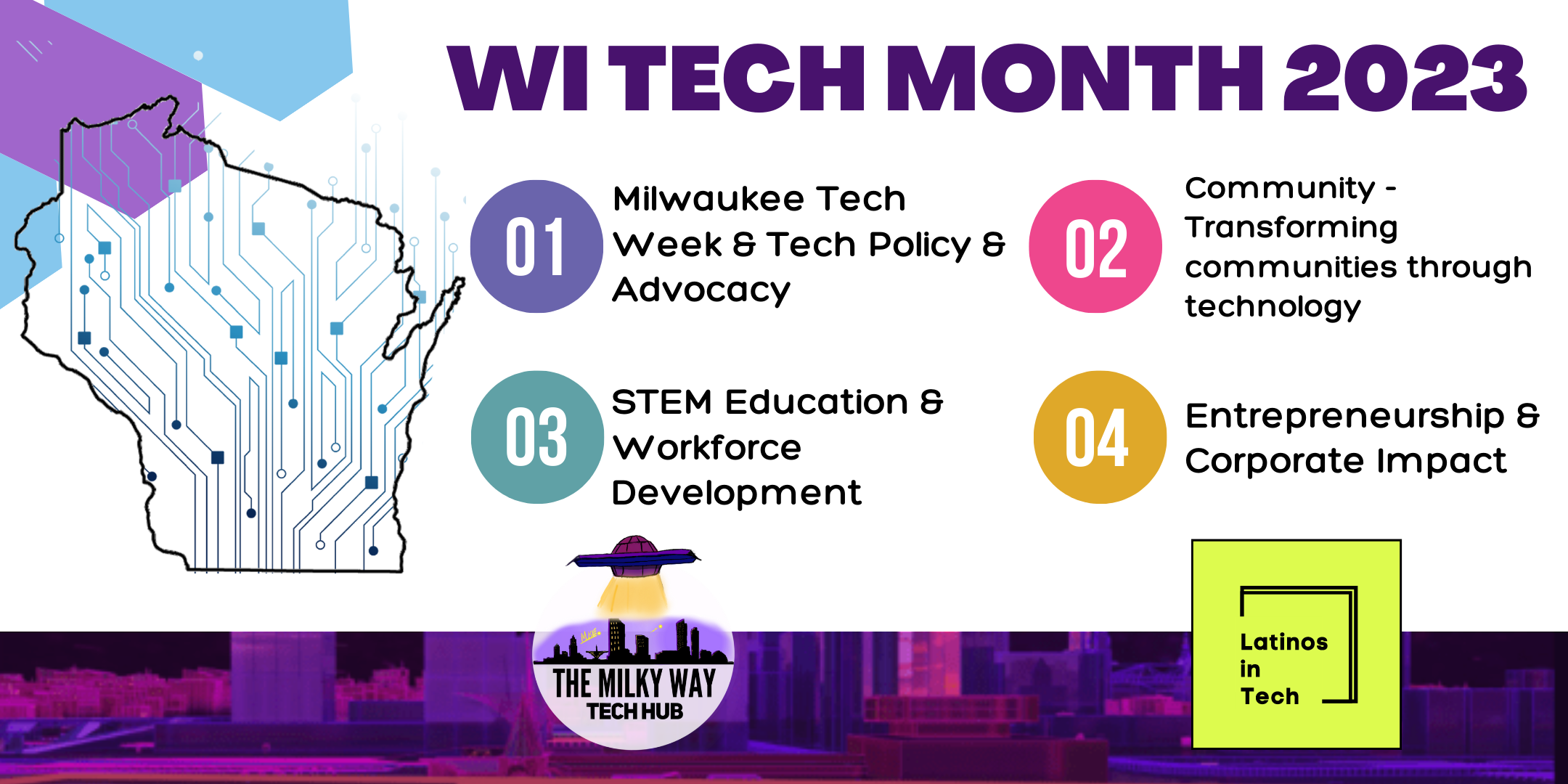October 2023 Tech Upload
| The NEW Digital Alliance would like to thank Thrivent and Faith Technologies Incorporated (FTI) for their support as an Executive Level investor! |  |
 |
NEW Digital News

October is WI Tech Month
WI Tech Month is a month-long celebration of the tech industry in Wisconsin that has taken place since 2021. The Initiative is led by Milky Way Tech Hub and Latinos in Tech. Governor Tony Evers issued a proclamation recognizing October as WI Tech Month, and the distinction has continued ever since.
WI Tech Month provides a platform for companies, organizations, and individuals to showcase their innovations, expertise, and accomplishments. This annual event will showcase the strength and potential of the tech industry in the state.
Physical Theft: An Overlooked Cause of Data Breaches
Sadoff E-Recycling & Data Destruction
Data breaches are a real concern for businesses of any size. However, when most people think of a data breach, they think of someone in a dark room hacking into your mainframe. That is rarely a reality for most businesses, mostly because it’s hard and time-consuming. A phishing scam is more likely to cause a breach, but what about physical theft? This overlooked cause of data breaches happens every day, and if you are not careful, you could be next. Let’s take a look at what physical data theft entails, who can fall prey to it, and what you can do to help prevent it.
What is Physical Data Theft?
When we say physical data theft, we are not talking about someone stealing notebooks and papers. The data is still digital, but instead of stealing it in the digital space through the internet, the thief gets their hands on the actual device that stores the data. This could be a cell phone, a thumb drive, a hard drive, or even a server rack.
What Will Data Thieves Do With Your Data?
There is a lot that can be done with your data depending on what type of information is housed there. If it’s client data, they can use the info to potentially get into your systems or even use that info against your clients and get into other aspects of their lives. This can be disastrous for your clients and for you as well. Trade secrets and more can also be used against you, and if your data device was used by an employee at some point, the thief might have access to a lot of personal data on that employee as well.
One of the big issues with physical data theft comes down to discovery. Most physical theft occurs in your blind spots. This means a piece of equipment that you weren’t monitoring or using gets stolen. A good data thief will know how to use that data to maximize personal gain before they expose the theft. The more time that goes by until discovery, the more damage can be done.
Who Can Fall Prey to Physical Data Theft?
This type of data theft can happen to anyone and depending on the thief and the data involved, the effects can range from mostly harmless to utterly disastrous.
No Such Thing as Too Small For a Data Breach
Not only can any business be subject to physical data theft, but if anything, small businesses are more susceptible. This is because most large companies already have processes in place to ensure the security of their data. We’ll get into these processes in a minute.
Not only is a small business more susceptible, but a physical theft can more easily destroy your business by ruining consumer confidence and being exceptionally costly to remedy. Most small businesses do not have the resources to weather that storm.
Artificial Intelligence, Factory Automation Initiatives and Securing Your Factory
The Manufacturing First Expo & Conference brings manufacturers from around the country together for hands-on opportunities to drive business growth, showcase industry advances, highlight successes and announce new developments.
It’s also an opportunity to explore the ever-evolving role of technology in manufacturing. Data is everywhere—and how we manage, store, access and apply it matters. Today’s manufacturers must keep pace with new technologies around logistics, artificial intelligence (AI), automation, supply chain connectivity, IoT applications, cybersecurity and more.
Production happens faster and more efficiently than ever, but keeping pace with new technologies will likely require more staffing and capital resource expenditures than initially planned—securing these new assets is critical.
John Kehoe, Executive Vice President of Manufacturing at Involta, will lead an informative breakout session on AI, automation and the importance of cybersecurity in manufacturing at the Manufacturing First Expo & Conference.
With 25 years of global experience across multiple industries, John is an accomplished senior executive with a proven track record of leading teams and empowering organizations to improve productivity, increase efficiency and drive digital transformation.
In his session, John will explore the manufacturing industry’s rapidly evolving technological landscape, with particular emphasis on:
- How to leverage AI for insights that can enhance efficiency, minimize downtime and allow for adaptive production.
- How measures like encryption, network segmentation and cybersecurity training can help protect data, intellectual property and operations from cyber threats.
- Evaluating potential business risks and technological solutions that can protect your business, improve productivity and enable your next phase of growth.
Involta has been a trusted partner for clients in manufacturing for nearly 20 years, offering world-class data center facilities, connectivity and infrastructure solutions designed to meet the most stringent security requirements. Involta recently completed the Department of Defense’s Cybersecurity Maturity Model Certification (CMMC). The company’s security-first approach set the foundation for achieving compliance with 109 of the 110 CMMC controls, and its manufacturing clients reap the many benefits of Involta’s industry-leading security standards.
7 Strategies to Attract and Retain Top Tech Talent
TEKsystems – May 2023
Companies with innovative workforce development strategies attract top talent, driving faster digital transformation and business success. Learn how to become a leading employer.
Adaptability is the name of the game for tech companies looking to stand out as top employers and innovators. The talent gap accelerated during the pandemic, changing workplace expectations, and amplifying the need for innovative recruitment and retention plans.
Why Is Workforce Development Crucial in Today’s Job Market?
Technology and business models are being pushed to evolve, driving demand for new skills and more talent in IT. Employers should take a fresh approach to workforce development, as professionals with in-demand skills and experience can be selective about the opportunities they decide to pursue.
Building a strong workforce development strategy requires focus and intention at every level of an organization. Breaking down unintentional bias in hiring and promotions should be foundational and structured around a flexible, continuous learning environment. Why not start today with reimagining your approach? The skills and talent gap continues to grow, and companies that fail to act will be hit at their bottom line:
- Increased attrition
- Missed opportunities from nontraditional talent sources
- Decreased revenue
These preventable issues are barriers to unlocking the full potential for business success.
Where to Start
To become a highly sought-after employer and a leader in workforce development, start with a new organizational approach that fosters opportunity, inclusion, flexibility and career advancement. This infographic breaks down the top seven tips to come out ahead in recruiting and retention.
Harnessing the Power: Companies Deploying Private GPTs & Training on Proprietary Data
August 1, 2023
By Steve Alix
EDCi
In this age of artificial intelligence (AI), companies are constantly seeking innovative ways to gain a competitive edge. One significant development in the realm of AI is the deployment of private GPT (Generative Pre-trained Transformer) models by companies, allowing them to train and utilize AI systems on their own proprietary data. This approach offers several advantages, such as enhanced customization, improved data privacy, and tailored solutions to meet specific business needs.
The Rise of Private GPTs
Traditionally, companies relied on pre-trained models and Application Program Interfaces (APIs) provided by tech giants or AI platforms to incorporate AI capabilities into their operations. However, with the advancements in AI research and infrastructure, many organizations are now taking control of their AI destiny by deploying private GPTs. These models are built on open-source frameworks like OpenAI’s GPT or Hugging Face’s Transformers, allowing companies to adapt and extend the pre-trained architecture to suit their specific requirements.
Customization and Adaptability
One of the main advantages of deploying private GPTs is the ability to tailor the models to specific business contexts. By training on their own data, companies can ensure that the AI system understands the intricacies of their industry, customer behavior, and internal processes. This customization enables more accurate predictions, better insights, and enhanced decision-making.
Moreover, private GPT models can be fine-tuned to address domain-specific challenges. For instance, an e-commerce company can train its private GPT to generate personalized product recommendations based on its vast transactional data. This fine-tuning process empowers companies to leverage AI in ways that align closely with their unique goals and objectives.
Regional News
Public comments open for state's digital equity plan

September 22, 2023
By Aaron Holbrook
Following months of public outreach and stakeholder engagement, the Public Service Commission of Wisconsin released the draft Wisconsin Digital Equity Plan for public comment.
Once approved by the commission, the Digital Equity Plan will guide the state’s strategy to improve digital equity, ensuring all in Wisconsin have the skills, devices, and broadband service necessary to fully participate in society and the economy.
The state plan is one of three components of the Digital Equity Act. Passed under the Bipartisan Infrastructure Law, the Digital Equity Act is intended to promote digital equity and inclusion. After the public comment period, the commission will review the public comments and finalize the plan during an open meeting for submission to the National Telecommunications Information Administration.
Upon NTIA approval, Wisconsin will be eligible for State Capacity Grant Program funding to implement the state’s Digital Equity Plan over a five-year period. Digital equity funding will be directed toward populations that have disproportionately faced internet access and adoption barriers, including rural residents, low-income residents, individuals of color, people with language barriers, aging individuals, incarcerated individuals, people with disabilities, and veterans.
“Digital equity is important because, for our state to fully realize the economic and social benefits of broadband, all must be able to successfully utilize the service,” said PSC Chairperson Rebecca Cameron Valcq. “The additional public comments will move us closer toward achieving our goal for all Wisconsinites to have equitable access to affordable broadband service and the capacity to fully engage in a digital society.”
The Digital Equity Plan is available here. Public comments will be accepted until Oct. 19. To submit a public comment under Docket 5-BP-2023, please visit the PSC’s Electronic Records Filing System.
AI interest rising fast, top searches include ChatGPT and BERT, Upwork reports

AUGUST 22, 2023 – AI was the fastest-growing category on Upwork during the first half of this year, the talent platform reported. Generative AI job posts on its platform rose more than 1,000% in the second quarter compared to the end of last year. In addition, related searches increased more than 1,500% in the same time period.
Upwork on Aug. 22 released new data from the past six months and found that ChatGPT and BERT were among the top 10 AI-related searches by clients on its platform. BERT stands for Bidirectional Encoder Representations from Transformers and is a natural language processing model proposed by researchers at Google, according to GeekforGeeks.org.
Here are the top 10 generative AI-related searches from client companies on Upwork from Jan. 1 to June 30:
- ChatGPT
- BERT
- Stable Diffusion
- TensorFlow
- AI chatbot
- Generative AI
- Image processing
- PyTorch
- Natural language processing
- Bard

Upwork said it has also seen a shift in search activity as businesses move from searching for singular generative AI tools to searching for AI applications and services. This shows hiring managers are understanding more about generative AI and its use cases, according to the company.
How cybercriminals are weaponizing artificial intelligence

While artificial intelligence (AI) technology can offer benefits in cybersecurity, it can also be weaponized by cybercriminals. As such, it’s crucial for businesses to understand the cyber risks associated with this technology and implement strategies to minimize these concerns.
This article outlines ways cybercriminals can utilize AI technology and provides tips to help businesses safeguard themselves against such weaponization.
The economic potential of generative AI: The next productivity frontier

June 14, 2023
McKinsey & Company
Generative AI is poised to unleash the next wave of productivity. We take a first look at where business value could accrue and the potential impacts on the workforce.
AI has permeated our lives incrementally, through everything from the tech powering our smartphones to autonomous-driving features on cars to the tools retailers use to surprise and delight consumers. As a result, its progress has been almost imperceptible. Clear milestones, such as when AlphaGo, an AI-based program developed by DeepMind, defeated a world champion Go player in 2016, were celebrated but then quickly faded from the public’s consciousness.
